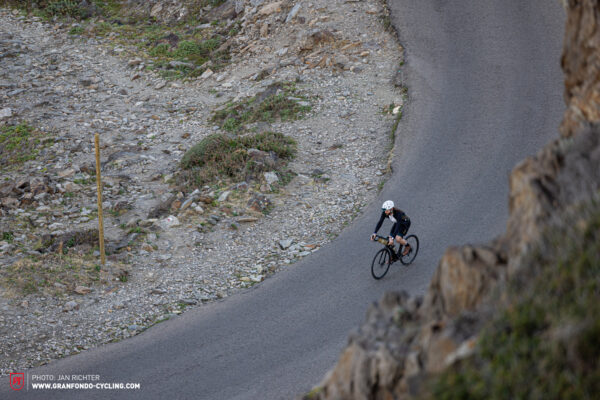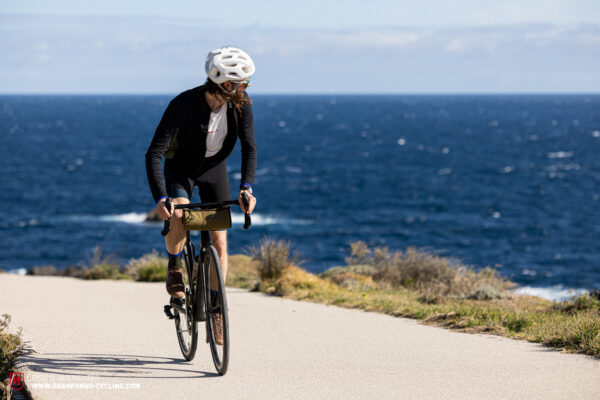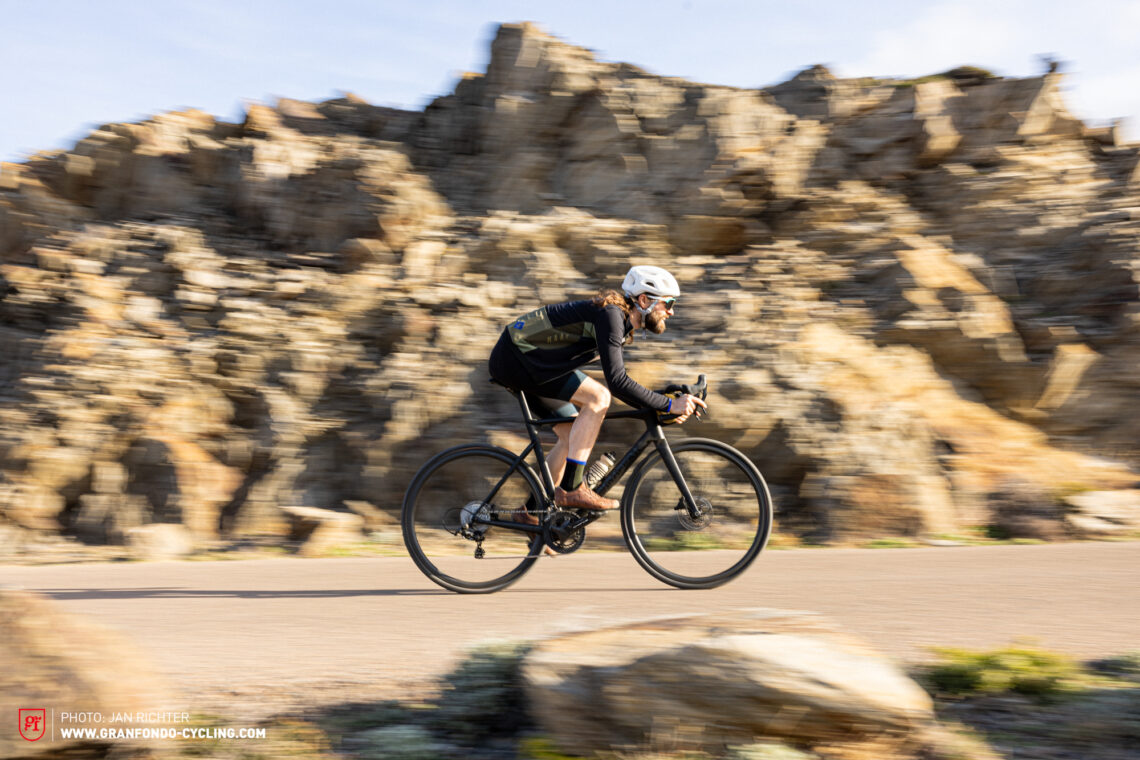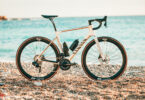All-road doesn’t have to mean riding at party pace. The Parapera Atmos² places the emphasis on performance, combining lightweight construction, aerodynamic optimisation, and a sporty attitude. Do these attributes even make sense off-road or is the Parapera Atmos² barking up the wrong tree?
This bike was tested as part of our 2023 all-road group test – you can find an overview of the group test and the featured bikes over here: The best all-road bike of 2023 – 10 all-road bikes in review

What is the product of steam x steam? According to Parapera: Atmos². That’s because in ancient Greek, atmós means steam. And applied to the brand’s two gravel and all-road models, Atmos and Atmos², it means even more speed. The Atmos² isn’t Atmos’ successor, but rather its leg-shaving younger sibling. The differences include integrated cabling, a one-piece cockpit, dropped seat stays, and a D-shaped seat post, resulting in a weight increase of about 300 g. The geometry is more aggressive, and the cockpit is lower due to the shorter head tube. With the Atmos², Parapera have approached the all-road concept from a different starting point than classic all-road bikes, but was it a good idea?


Smoke and mirrors – What is the Parapera Atmos² capable of
Speed is the top priority! The changes on the Parapera Atmos² are said to offer improved aerodynamics and thus allow you to ride faster compared with the Atmos. While proving whether this is in fact the case is difficult to do, the Parapera Atmos² certainly looks a lot faster, almost as though it was sculpted from a single block. With Parapera’s signature matte black look, it exudes a certain level of elegance and exclusivity. Added to that is the discreet and beautiful branding with glossy black lettering and a minimalistic logo. The result: a fast yet elegant look. The aero upgrades, like the in-house D-shaped seat post and one-piece cockpit, also make for a very clean look. This impression is underlined by the complete absence of eyelets for accessories.

As is also typical of Parapera, the drivetrain is taken care of by Campagnolo, true to the motto: exclusive bike with exclusive components. Not so typical, on the other hand, is the fact that our test bike came equipped with the mechanical Campagnolo Chorus groupset. In the hierarchy, this is equivalent to somewhere between the Shimano 105 and Shimano ULTEGRA groupsets, i.e. mid to upper range. However, the 2×12 drivetrain consisting of 11–34 t cassette and 48/32 t crankset isn’t available in Parapera’s online configurator. There, you’re limited to Campagnolo Super Record EPS, Shimano 105 Di2, or Shimano ULTEGRA Di2. If you opt for a Shimano groupset, the premium Parapera Carbon SLS wheelset with robust Tune Prince/Princess hubs and a tubeless setup are replaced by a Mavic Cosmic SL carbon wheelset with 45 mm deep rims. These are paired with 30 mm wide Schwalbe Pro One Speed tires with tubes. You also get the one-piece handlebar and stem unit, featuring a relatively long 120mm stem mated to a 44 cm wide handlebar. The handlebar width and stem length vary depending on the frame size. Although this configuration isn’t available online, our test bike proves that the integrated cable routing also works with a mechanical drivetrain. Tipping the scales at just 7.32 kg, it’s the lightest all-road bike in our test field, and exactly 1 kg lighter than the average. And you get all this for € 5,350 (or € 5,464 with the Shimano 105 Di2 groupset), which is well below the analogue bike average of € 7,000 (€ 7,370 including ebikes).

The Prince and Princess hubs from Tune are super robust and versatile.

The thumb levers on the Campagnolo Chorus groupset work well, they just don’t look all that clean.

At least in terms of comfort, by making the most of the 34 mm tire clearance.
Parapera Atmos²
€ 5,390
Specifications
Seatpost Parapera Carbon Aero D-shaped
Brakes Campagnolo Corus 160 mm
Drivetrain Campagnolo Corus 2x12
Stem Parapera Carbon Aero 120 mm
Handlebar Parapera Carbon Aero 440 mm
Wheelset Parapera Carbon SLS 30
Tires Schwalbe Pro One 700x32c
Technical Data
Size XS S M L XL
Weight 7,32 kg
Specific Features
Sophisticated aero concept
Clean look thanks to the one-piece cockpit
Premium Parapera wheels
Rare Italian Campagnolo groupset

The frame’s aero features also make the Parapera Atmos² look faster.

The handlebar doesn’t just offer aero advantages, but also provides ergonomic benefits.
| Size | XS | S | M | L | XL |
|---|---|---|---|---|---|
| Seat tube | 460 mm | 485 mm | 510 mm | 535 mm | 565 mm |
| Top tube | 510 mm | 527 mm | 542 mm | 562 mm | 581 mm |
| Head tube | 102 mm | 120 mm | 135 mm | 155 mm | 180 mm |
| Head angle | 70.5° | 71.5° | 72.5° | 72.5° | 73.0° |
| Seat angle | 74.5° | 74.5° | 74.0° | 73.5° | 73.0° |
| Chainstays | 408 mm | 405 mm | 405 mm | 410 mm | 410 mm |
| BB Drop | 70 mm | 70 mm | 70 mm | 70 mm | 70 mm |
| Wheelbase | 975 mm | 981 mm | 985 mm | 1,000 mm | 1,014 mm |
| Reach | 374 mm | 381 mm | 388 mm | 395 mm | 402 mm |
| Stack | 500 mm | 514 mm | 541 mm | 562 mm | 575 mm |



Letting off steam – The Parapera Atmos² on the test track
The Parapera Atmos² definitely looks like it wants to let off steam and blast off. You’ll have to get used to the very aggressive riding position before tucking in and getting going. The stretched and low riding position is due above all to the long stem and short head tube. This gives you an aerodynamic advantage, of course, but it also requires a certain degree of fitness and flexibility – especially on long distances. Due to the stretched riding position, the weight distribution is also shifted forward, which influences the bike’s handling significantly. As such, it offers plenty of stability on fast straights, but once you hit winding roads and sharp bends, you’ll have to muscle the bike around the corners. In a nutshell: speed and straight-line stability? 100%! Agility? Not so much. While it’s a lot of fun on long straights, the lack of agility can become a bit annoying on tight, fast corners. It requires an experienced rider to compensate for the bike’s stubbornness through the corners.
In addition to the weight, handling, and riding position, the bike’s compliance is also characterised by its racing genes. The Parapera Atmos² is on the stiffer end of the spectrum, passing impacts from the ground onto the rider, unmitigated by the seat post or frame. This isn’t a big issue on smooth to rough asphalt, but as soon as things get bumpy, the Parapera Atmos² quickly feels out of its depth. On the other hand, the all-road bike is quick to respond when you step on the pedals, whether on a climb or level terrain. The Campagnolo Chorus drivetrain is top-notch for a mid-range groupset, though the thumb shifters aren’t for everyone, both in terms of looks and functionally. That said, the Campagnolo brake levers were the most popular in the entire test field. The one-piece cockpit also fares excellently in terms of ergonomics.
The Parapera Atmos² goes like a rocket, but it requires a skilled rider to handle it.

Pants Maap Alt_Road Cargo Bib | Shoes Dromarti Road Shuhe | Socks´ Maap Alt_Road Trail Sock | Special Tudor Black Bay Chrono
Who is the Parapera Atmos² for?
The Parapera Atmos² is clearly aimed at competitive and experienced riders. Anyone who already has a high 5-digit figure on their lifetime cycling odometer and is looking for a fast all-road bike to mainly ride on asphalt should consider the Parapera Atmos². If you max out the 34 mm tire clearance, there’s nothing to stop you from taking the occasional woodland detour, but your focus should be on asphalt and speed, nonetheless. All-road weight-weenies will also have fun with this bike.


Tuning tip: 34 mm tires for more comfort
Riding Characteristics
4Agility
- cumbersome
- playful
Stability
- nervous
- confident
Handling
- demanding
- balanced
Fun factor
- boring
- lively
Comfort
- firm
- comfortable
Value for money
- terrible
- very good
Conclusion on the Parapera Atmos²
The Parapera Atmos² is all about speed, aerodynamics, and minimal weight. The premium looking all-road bike ticks all of the above. However, these characteristics come at the expense of compliance and agility. As such, it’s unsuitable for longer off-road excursions. Ultimately, the Parapera Atmos² is a good-looking, fast, and ambitious road racer capable of accommodating relatively wide tires. A real jack of all trades, and master of some.
Tops
- sexy design and finish
- fast and furious on asphalt
- excellent brake lever ergonomics of the Campagnolo Chorus groupset
Flops
- limited off-road capability and lack of practical features

You can find out more about at parapera-bikes.de
The testfield
This bike was tested as part of our 2023 all-road group test – you can find an overview of the group test and the featured bikes over here: The best all-road bike of 2023 – 10 all-road bikes in review
All bikes on review: Argon 18 Krypton (Click for review) | Merida Scultura Endurance 9000 (Click for review) | Parapera Atmos² | Pinarello X (Click for review) | Rondo Ratt CF (Click for review) | Rose Reveal Plus (Click for review) | Scott Solace eRide 10 (Click for review) | Specialized Roubaix Comp (Click for review) | Trek Domane SLR 7 AXS Gen 4 (Click for review) | Wilier Granturismo SLR (Click for review)

No, it’s not about perfect race tracks, it’s about efficiency. Fast, fleet-footed and efficient – those who want to speed along high-speed passages need a defined and spritely bike that accelerates with ease and efficiency. Nevertheless, reliable components are important too. We interpret “Smooth tarmac” bikes as follows: Hard efforts at high speeds with a maximum efficient bike on a consistently well-paved road. Effort-joy ratio: 80:30 (not everything has to be 100%!)↩
… also known as bike riding. Broken-up roads in the hinterland, deadlocked gravel roads, loose surfaces – sometimes muddy, sometimes bone-dry. For this, it takes bikes with super all-round, handling and wearing qualities uphill and downhill. Effort-joy ratio: 50:50↩
If you want to use your bike almost every day, you usually do not need an extremely tuned racing machine. Solid components, which are able to cope with the rigours of continuous usage in any kind of weather, are part of the basic equipment. At the same time, the bike should have practicable details: integrated fenders/assembly options, luggage racks/attachment points and a light system or at least the option of installing bike lights. The position on the bike should be rather relaxed, the overall comfort high, so that the Afterwork Ride becomes a cure and not a curse. Effort-joy ratio: 30:70↩
You can find more info about our rating system in this article: Click here! ↩
Did you enjoy this article? If so, we would be stoked if you decide to support us with a monthly contribution. By becoming a supporter of GRAN FONDO, you will help secure a sustainable future for high-quality cycling journalism. Click here to learn more.
Words: Martin Staffa Photos: Jan Richter







